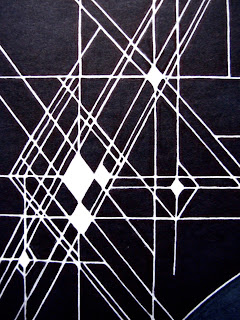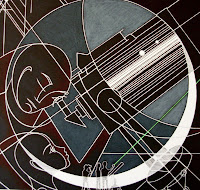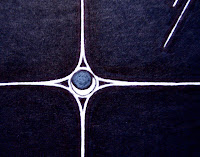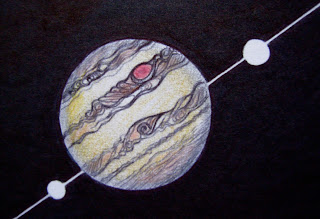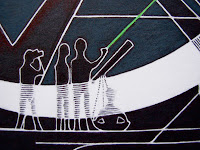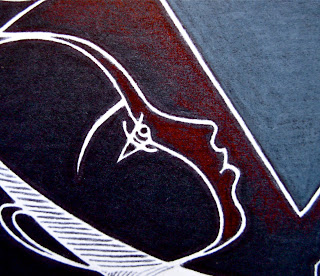 This latest project of reinterpreting astronomical subjects has been really enjoyable for me. Though most of the drawings have required a mind-numbing amount of painstaking sharpie work, experiencing every small step as definite progress toward a specific goal has helped keep my head above water during a time when the rest of my professional life is mired in uncertainty. I guess that's one thing that has always appealed to me about drawing, and perhaps why I've gravitated toward the stark materials and style that have become my standard. Once a line is applied to the paper, it remains. Once a work is complete, it can be easily and repeatedly viewed in its original finished form without concern for physical alteration. No matter my physical or mental condition, if I need to demonstrate my creative accomplishment, I can always pull out a drawing or two for display.
This latest project of reinterpreting astronomical subjects has been really enjoyable for me. Though most of the drawings have required a mind-numbing amount of painstaking sharpie work, experiencing every small step as definite progress toward a specific goal has helped keep my head above water during a time when the rest of my professional life is mired in uncertainty. I guess that's one thing that has always appealed to me about drawing, and perhaps why I've gravitated toward the stark materials and style that have become my standard. Once a line is applied to the paper, it remains. Once a work is complete, it can be easily and repeatedly viewed in its original finished form without concern for physical alteration. No matter my physical or mental condition, if I need to demonstrate my creative accomplishment, I can always pull out a drawing or two for display.Creation for a musician, however, exists from moment to moment, and concrete impressions of a performance recede into the forgetful past soon after its final notes have dissipated. True, recordings can mediate this to some extent, providing an exactly repeatable performance at the press of a few buttons, but just as a Van Gogh print doesn't do justice to the texture and color of the original, even the most faithful recording cannot capture the richness and depth of live performance.
 A performing musician strives for an elite physical capacity that infuses flawless technique with profound artistry and enables both to be called up in front of an audience on demand. One great performance of a piece does not necessarily guarantee another. Just because I once had a very successful performance of the Arutunian Trumpet Concerto (played here by Tine Thing Helseth), doesn't mean I can just push my internal Arutunian button and play it all again for you right now. Staging a repeat performance would require several weeks of practice and rehearsal. Musical ability is active, dynamic...and impermanent. The highest standards of proficiency must be rigorously maintained. In the best of times, this practice is exhilarating. During tougher times it can can be exhausting, discouraging, and downright terrifying.
A performing musician strives for an elite physical capacity that infuses flawless technique with profound artistry and enables both to be called up in front of an audience on demand. One great performance of a piece does not necessarily guarantee another. Just because I once had a very successful performance of the Arutunian Trumpet Concerto (played here by Tine Thing Helseth), doesn't mean I can just push my internal Arutunian button and play it all again for you right now. Staging a repeat performance would require several weeks of practice and rehearsal. Musical ability is active, dynamic...and impermanent. The highest standards of proficiency must be rigorously maintained. In the best of times, this practice is exhilarating. During tougher times it can can be exhausting, discouraging, and downright terrifying.I suppose this comparison is a bit simplistic. It's never desirable to sit back and "rest on your laurels" so to speak, and I'm of course always trying to improve my ability as a visual artist as well.
While waiting for my newest formal ideas to gestate, I've been experimenting with new techniques just for fun. I tried sketching more views of the moon through the eyepiece of my borrowed dobsonian, but had quite a lot of trouble. Those sketches went straight into the recycling bin! Though as I think about it now, maybe I should've saved them just as a laugh. In any case, I decided I'd need some practice before going out again, so yesterday I tried sketching a lunar landscape using an online photo as a reference...and as an added experiment, employed scribbling as my method...
The scribbles appearing earlier in this post show a few "details" close up.
In a way, the roughness of these scribbles--the way they resolve at a distance into something resembling a recognizable object--reminds me that all of it...the music, the drawing, my career, my life...is a never ending work in progress. I can't help striving for improvement and even yearning for (an unachievable) perfection, and it's often difficult to forge through tough times still believing that things will eventually work out. But in my better moments I remember to step back and take the long view. Sometimes those scribbles do add up.



